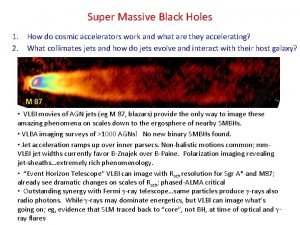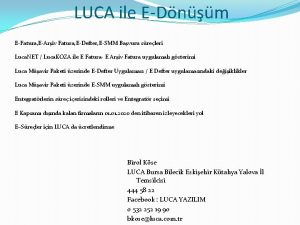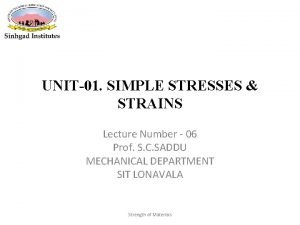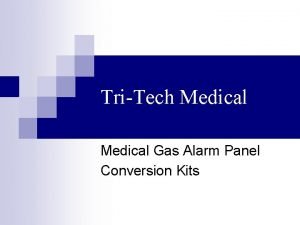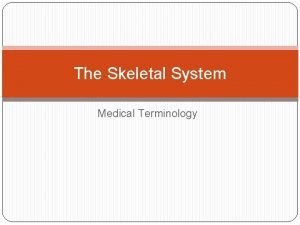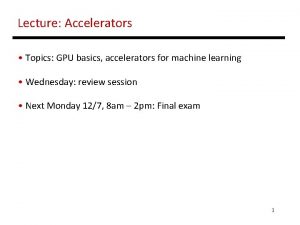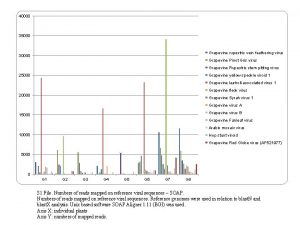Review of medical accelerators L G Sukhikh 30000























































- Slides: 55

Review of medical accelerators L. G. Sukhikh

30000 Accelerators in the world Courtesy R. Baily 2

Accelerators in medicine 1. Accelerators for treatment 2. Accelerators for radiopharmaceuticals production 3. Indirect use (e. g. sterilization) 3

Radiation sterilization • E. g. syringes sterilization 4 BINP, Novosibirsk

Radiopharmaceutical production • Pharmaceuticals for nuclear diagnostics: gamma and positron emitters: F-18, N-15, Tc-99 etc. • Pharmaceuticals for nuclear treatment: beta emitters P-32, Sr-89, etc. 5

PET 6

Particle accelerators: Cyclotron • In a cyclotron the heavy particles (protons, ions) are accelerated along a spiral trajectory guided inside two evacuated half-cylindrical electrodes (dees) by a uniform magnetic field produced between the pole pieces of a large magnet (1 T). 7

Fluorine-18 production 8

Fluorine-18 production Proton energies 11 -18 Me. V Currents 50 -300 u. A 9

Radionuclides for nuclear therapy 10

RADIATION THERAPY 11

Radiation treatment - radiotherapy • >95% of radiation therapy is used for cancer treatment 12

Radiation • • Ionizing radiation is DANGEROUS! 1 Gy (J/kg) per whole body – radiation disease 7 Gy per whole body – 95% lethal result in a few weeks 20 -25 Gy per whole body – lethal result in 30 min 13

Radiobiology • Radiation kills cells mainly via DNA damage 14

Tumour control probability • TCP and NTCP vs. dose • Minimal complications of normal tissues and organs are desired 15 B point – 35 -70 Gy •

Typical medical accelerator For a radiotherapist Black box Dose distribution 16

Dose in water 17

ELECTRON MACHINES 18

Particle accelerators: Betatron • • Betatron is a cyclic induction accelerator in which the electrons are made to circulate in a toroidal vacuum chamber (doughnut) that is placed into a gap between two magnet poles. Conceptually, the betatron may be considered an analog of a transformer: – Primary current is the alternating current exciting the magnet. – Secondary current is the electron current circulating in the doughnut. 19

Particle accelerators: Betatron • Betatrons were used for external RT in 70 -th, 80 -th Finland Great Britain 20

Particle accelerators: Betatron • Betatrons now are used only for Intraoperative radiotherapy with Me. V electron beams 21

Particle accelerators: Betatron • Betatrons now are used only for Intraoperative radiotherapy with Me. V electron beams 22

LINACS • Medical linacs accelerate electrons to kinetic energies from 4 to 25 Me. V using microwave radiofrequency fields: – 103 MHz : L band – 2856 MHz: S band – 104 MHz: X band • In a linac the electrons are accelerated following straight trajectories in special evacuated structures called accelerating waveguides. 23

LINACS • During the past 40 years medical linacs have gone through five distinct generations, each one increasingly more sophisticated: (1) (2) (3) (4) (5) Low energy x rays (4 -6 MV) Medium energy x rays (10 -15 MV) and electrons High energy x rays (18 -25 MV) and electrons Computer controlled dual energy linac with electrons combined with intensity modulation 24

LINACS • Linacs are usually mounted isocentrically and the operational systems are distributed over five major and distinct sections of the machine: – Gantry stand support – Modulator – Patient support assembly – Control console 25

LINACS: configuration • In the simplest and most practical configuration: – Electron source and the x-ray target form part of the accelerating waveguide and are aligned directly with the linac isocentre obviating the need for a beam transport system. – Since the target is embedded into the waveguide, this linac type cannot produce electron beams. 26

Configuration of modern linacs 27

LINACS: configuration • For both electrons and photons (Varian): 28

LINACS: configuration Alpha 29

Configuration of modern linacs Typical modern dual energy linac, incorporating imaging system and electronic portal imaging device (EPID), Elekta, Stockholm 30

Configuration of modern linacs Typical modern dual energy linac, with on board imaging system and an electronic portal imaging device (EPID), Varian, Palo Alto, CA, USA 31

Configuration of modern linacs 32

Electron beam transport Three systems for electron beam bending have been developed: 90 o bending 270 o bending 112. 5 o (slalom) bending 33

Clinical X-ray beam 34

Clinical X-ray beam • Typical electron pulses arriving on the x-ray target of a linac. Typical values: Pulse height: 50 m. A s Pulse duration: 2 Repetition rate: 100 Hz • Period: 104 s The target is insulated from ground, acts as a Faraday cup, and allows measurement of the electron charge striking the target. 35

Clinical electron beam 36

Multileaf collimator 37

Conventional EBRT Rectangular shape 38

3 D-CRT 39

IMRT and VMAT 40

PROTON MACHINES 41

Dose depth distribution 42

Spread of Bragg peak Tumour Proton energy 70 -250 Me. V 43

Pencil beam scanning 44

Single scattering 45

Uniform scanning (wobbling) 46

Intensity modulation pencil beam Fast intensity modulation is needed (easier with CW isochronous cyclotrons) 47

Main blocks Accelerator Energy selection Beam transport Gantry 48 Courtesy M. Schippers

Building 49

Accelerator 1. Cyclotron: fixed energy, energy modulation is needed, CW 2. Synchrotron: variable energy, complexity 50

Energy degrader (PSI) 51

Gantry 52

Main manufactures Germany (RP) USA (PT) GE, USA (RP) USA (PT) Japan (RP+PT) Canada (RP) C 235 Canada (RP) Belgium (RP+PT) 53

Conclusions 1. Roughly 35% of accelerator are used for medical purposes, mainly radiotherapy. 2. Electron linacs are the main “working horses” that are developed in the direction of precise dose delivery 3. Proton therapy is widely developed but still to expensive and complicated, mostly because of beam transport and delivery. 54

Thank you for your Attention! 55
 The long-term future of particle accelerators
The long-term future of particle accelerators Accelerators computer architecture
Accelerators computer architecture Kotter 8 accelerators
Kotter 8 accelerators Good to great technology accelerators
Good to great technology accelerators Good to great chapter 7 summary
Good to great chapter 7 summary Cosmic super accelerators
Cosmic super accelerators Analytics query accelerators
Analytics query accelerators 30000 in english
30000 in english 350000000/30000
350000000/30000 150000000/10000
150000000/10000 350000000/30000
350000000/30000 350000000/30000
350000000/30000 Nettefatura işnet
Nettefatura işnet Andy basheer
Andy basheer 30000/12/10
30000/12/10 35000+30000
35000+30000 Tener 30000 euros ahorrados
Tener 30000 euros ahorrados Singkatan newton
Singkatan newton 1 30000
1 30000 Doctors license number
Doctors license number Gbmc infoweb
Gbmc infoweb Difference between medical report and medical certificate
Difference between medical report and medical certificate Torrance memorial medical center medical records
Torrance memorial medical center medical records Cartersville medical center medical records
Cartersville medical center medical records Odsp medical form
Odsp medical form Mosby pronunciation
Mosby pronunciation Chapter review motion part a vocabulary review answer key
Chapter review motion part a vocabulary review answer key Uncontrollable spending ap gov
Uncontrollable spending ap gov Narrative review vs systematic review
Narrative review vs systematic review What is inclusion and exclusion
What is inclusion and exclusion Narrative review vs systematic review
Narrative review vs systematic review Wyndham hotel medical center
Wyndham hotel medical center Medical manuscript writing
Medical manuscript writing -in suffix medical term
-in suffix medical term Wootton medical centre
Wootton medical centre Dr steven shapiro
Dr steven shapiro Tifr medical section
Tifr medical section Sway back posture
Sway back posture Patient centered medical home conference
Patient centered medical home conference Queen anne medical electrolysis and laser
Queen anne medical electrolysis and laser Odo268 swiss medical
Odo268 swiss medical Chapter 11 medical terminology
Chapter 11 medical terminology Aok pte curriculum
Aok pte curriculum University medical centre maribor
University medical centre maribor Eponym examples medical
Eponym examples medical Umass pharmacy residency
Umass pharmacy residency Tcm hospital malaysia
Tcm hospital malaysia Ohmeda medical gas outlets
Ohmeda medical gas outlets Chemetron medical gas alarm panel
Chemetron medical gas alarm panel Tiu medical analysis
Tiu medical analysis Vermont medical examiner
Vermont medical examiner Medical terminology skeletal system
Medical terminology skeletal system Integrative medicine santa rosa
Integrative medicine santa rosa Sce medical abbreviation lungs
Sce medical abbreviation lungs Problem-oriented medical record example
Problem-oriented medical record example Pomr medical
Pomr medical





